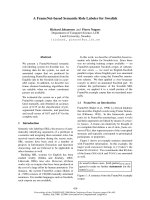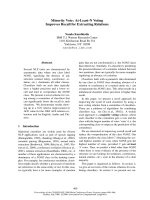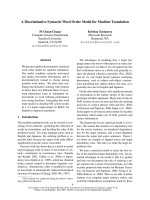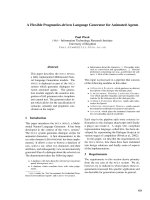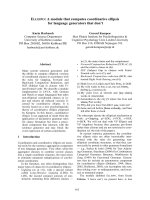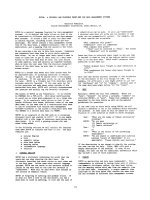Báo cáo khoa học: "A Seed-driven Bottom-up Machine Learning Framework for Extracting Relations of Various Complexity" pdf
Bạn đang xem bản rút gọn của tài liệu. Xem và tải ngay bản đầy đủ của tài liệu tại đây (913.46 KB, 8 trang )
Proceedings of the 45th Annual Meeting of the Association of Computational Linguistics, pages 584–591,
Prague, Czech Republic, June 2007.
c
2007 Association for Computational Linguistics
A Seed-driven Bottom-up Machine Learning Framework
for Extracting Relations of Various Complexity
Feiyu Xu, Hans Uszkoreit and Hong Li
Language Technology Lab, DFKI GmbH
Stuhlsatzenhausweg 3, D-66123 Saarbruecken
{feiyu,uszkoreit,hongli}@dfki.de
Abstract
A minimally supervised machine learning
framework is described for extracting rela-
tions of various complexity. Bootstrapping
starts from a small set of n-ary relation in-
stances as “seeds”, in order to automati-
cally learn pattern rules from parsed data,
which then can extract new instances of the
relation and its projections. We propose a
novel rule representation enabling the
composition of n-ary relation rules on top
of the rules for projections of the relation.
The compositional approach to rule con-
struction is supported by a bottom-up pat-
tern extraction method. In comparison to
other automatic approaches, our rules can-
not only localize relation arguments but
also assign their exact target argument
roles. The method is evaluated in two
tasks: the extraction of Nobel Prize awards
and management succession events. Perfor-
mance for the new Nobel Prize task is
strong. For the management succession
task the results compare favorably with
those of existing pattern acquisition ap-
proaches.
1 Introduction
Information extraction (IE) has the task to discover
n-tuples of relevant items (entities) belonging to an
n-ary relation in natural language documents. One
of the central goals of the ACE program
1
is to de-
velop a more systematically grounded approach to
IE starting from elementary entities, binary rela-
1
tions to n-ary relations such as events. Current
semi- or unsupervised approaches to automatic
pattern acquisition are either limited to a certain
linguistic representation (e.g., subject-verb-object),
or only deal with binary relations, or cannot assign
slot filler roles to the extracted arguments, or do
not have good selection and filtering methods to
handle the large number of tree patterns (Riloff,
1996; Agichtein and Gravano, 2000; Yangarber,
2003; Sudo et al., 2003; Greenwood and Stevenson,
2006; Stevenson and Greenwood, 2006). Most of
these approaches do not consider the linguistic in-
teraction between relations and their projections on
k dimensional subspaces where 1≤k<n, which is
important for scalability and reusability of rules.
Stevenson and Greenwood (2006) present a sys-
tematic investigation of the pattern representation
models and point out that substructures of the lin-
guistic representation and the access to the embed-
ded structures are important for obtaining a good
coverage of the pattern acquisition. However, all
considered representation models (subject-verb-
object, chain model, linked chain model and sub-
tree model) are verb-centered. Relations embedded
in non-verb constructions such as a compound
noun cannot be discovered:
(1) the 2005 Nobel Peace Prize
(1) describes a ternary relation referring to three
properties of a prize: year, area and prize name.
We also observe that the automatically acquired
patterns in Riloff (1996), Yangarber (2003), Sudo
et al. (2003), Greenwood and Stevenson (2006)
cannot be directly used as relation extraction rules
because the relation-specific argument role infor-
mation is missing. E.g., in the management succes-
sion domain that concerns the identification of job
changing events, a person can either move into a
584
job (called Person_In) or leave a job (called Per-
son_Out). (2) is a simplified example of patterns
extracted by these systems:
(2) <subject: person> verb <object:organisation>
In (2), there is no further specification of whether
the person entity in the subject position is Per-
son_In or Person_Out.
The ambitious goal of our approach is to provide
a general framework for the extraction of relations
and events with various complexity. Within this
framework, the IE system learns extraction pat-
terns automatically and induces rules of various
complexity systematically, starting from sample
relation instances as seeds. The arity of the seed
determines the complexity of extracted relations.
The seed helps us to identify the explicit linguistic
expressions containing mentionings of relation in-
stances or instances of their k-ary projections
where 1≤k<n. Because our seed samples are not
linguistic patterns, the learning system is not re-
stricted to a particular linguistic representation and
is therefore suitable for various linguistic analysis
methods and representation formats. The pattern
discovery is bottom-up and compositional, i.e.,
complex patterns can build on top of simple pat-
terns for projections.
We propose a rule representation that supports
this strategy. Therefore, our learning approach is
seed-driven and bottom-up. Here we use depend-
ency trees as input for pattern extraction. We con-
sider only trees or their subtrees containing seed
arguments. Therefore, our method is much more
efficient than the subtree model of Sudo et al.,
(2003), where all subtrees containing verbs are
taken into account. Our pattern rule ranking and
filtering method considers two aspects of a pattern:
its domain relevance and the trustworthiness of its
origin. We tested our framework in two domains:
Nobel Prize awards and management succession.
Evaluations have been conducted to investigate the
performance with respect to the seed parameters:
the number of seeds and the influence of data size
and its redundancy property. The whole system
has been evaluated for the two domains consider-
ing precision and recall. We utilize the evaluation
strategy “Ideal Matrix” of Agichtein and Gravano
(2000) to deal with unannotated test data.
The remainder of the paper is organised as fol-
lows: Section 2 provides an overview of the system
architecture. Section 3 discusses the rule represen-
tation. In Section 4, a detailed description of the
seed-driven bottom-up pattern acquisition is pre-
sented. Section 5 describes our experiments with
pattern ranking, filtering and rule induction. Sec-
tion 6 presents the experiments and evaluations for
the two application domains. Section 7 provides a
conclusion and an outline of future work.
2 System Architecture
Given the framework, our system architecture
can be depicted as follows:
Figure 1. Architecture
This architecture has been inspired by several
existing seed-oriented minimally supervised ma-
chine learning systems, in particular by Snowball
(Agichtein and Gravano, 2000) and ExDisco
(Yangarber et al., 2000). We call our system
DARE, standing for “Domain Adaptive Relation
Extraction based on Seeds”. DARE contains four
major components: linguistic annotation, classifier,
rule learning and relation extraction. The first com-
ponent only applies once, while the last three com-
ponents are integrated in a bootstrapping loop. At
each iteration, rules will be learned based on the
seed and then new relation instances will be ex-
tracted by applying the learned rules. The new re-
lation instances are then used as seeds for the next
iteration of the learning cycle. The cycle termi-
nates when no new relations can be acquired.
The linguistic annotation is responsible for en-
riching the natural language texts with linguistic
information such as named entities and depend-
ency structures. In our framework, the depth of the
linguistic annotation can be varied depending on
the domain and the available resources.
The classifier has the task to deliver relevant
paragraphs and sentences that contain seed ele-
ments. It has three subcomponents: document re-
585
trieval, paragraph retrieval and sentence retrieval.
The document retrieval component utilizes the
open source IR-system Lucene
2
. A translation step
is built in to convert the seed into the proper IR
query format. As explained in Xu et al. (2006), we
generate all possible lexical variants of the seed
arguments to boost the retrieval coverage and for-
mulate a boolean query where the arguments are
connected via conjunction and the lexical variants
are associated via disjunction. However, the trans-
lation could be modified. The task of paragraph
retrieval is to find text snippets from the relevant
documents where the seed relation arguments co-
occur. Given the paragraphs, a sentence containing
at least two arguments of a seed relation will be
regarded as relevant.
As mentioned above, the rule learning compo-
nent constitutes the core of our system. It identifies
patterns from the annotated documents inducing
extraction rules from the patterns, and validates
them. In section 4, we will give a detailed expla-
nation of this component.
The relation extraction component applies the
newly learned rules to the relevant documents and
extracts relation instances. The validated relation
instances will then be used as new seeds for the
next iteration.
3 DARE Rule Representation
Our rule representation is designed to specify the
location and the role of the arguments w.r.t. the
target relation in a linguistic construction. In our
framework, the rules should not be restricted to a
particular linguistic representation and should be
adaptable to various NLP tools on demand. A
DARE rule is allowed to call further DARE rules
that extract a subset of the arguments. Let us step
through some example rules for the prize award
domain. One of the target relations in the domain is
about a person who obtains a special prize in a cer-
tain area in a certain year, namely, a quaternary
tuple, see (3). (4) is a domain relevant sentence.
(3) <recipient, prize, area, year>
(4) Mohamed ElBaradei won the 2005 Nobel
Peace Prize on Friday for his efforts to limit the
spread of atomic weapons.
(5) is a rule that extracts a ternary projection in-
stance <prize, area, year> from a noun phrase
2
compound, while (6) is a rule which triggers (5) in
its object argument and extracts all four arguments.
(5) and (6) are useful rules for extracting argu-
ments from (4).
(5)
(6)
Next we provide a definition of a DARE rule:
A DARE rule has three components
1. rule name: r
i
;
2. output: a set A containing the n arguments
of the n-ary relation, labelled with their ar-
gument roles;
3. rule body in AVM format containing:
- specific linguistic labels or attributes
(e.g., subject, object, head, mod), de-
rived from the linguistic analysis, e.g.,
dependency structures and the named en-
tity information
- rule: its value is a DARE rule which ex-
tracts a subset of arguments of A
The rule in (6) is a typical DARE rule. Its sub-
ject and object descriptions call appropriate DARE
rules that extract a subset of the output relation
arguments. The advantages of this rule representa-
tion strategy are that (1) it supports the bottom-up
rule composition; (2) it is expressive enough for
the representation of rules of various complexity;
(3) it reflects the precise linguistic relationship
among the relation arguments and reduces the
template merging task in the later phase; (4) the
rules for the subset of arguments may be reused for
other relation extraction tasks.
The rule representation models for automatic or
unsupervised pattern rule extraction discussed by
586
Stevenson and Greenwood (2006) do not account
for these considerations.
4 Seed-driven Bottom-up Rule Learning
Two main approaches to seed construction have
been discussed in the literature: pattern-oriented
(e.g., ExDisco) and semantics-oriented (e.g.,
Snowball) strategies. The pattern-oriented method
suffers from poor coverage because it makes the IE
task too dependent on one linguistic representation
construction (e.g., subject-verb-object) and has
moreover ignored the fact that semantic relations
and events could be dispersed over different sub-
structures of the linguistic representation. In prac-
tice, several tuples extracted by different patterns
can contribute to one complex relation instance.
The semantics-oriented method uses relation in-
stances as seeds. It can easily be adapted to all re-
lation/event instances. The complexity of the target
relation is not restricted by the expressiveness of
the seed pattern representation. In Brin (1998) and
Agichtein and Gravano (2000), the semantics-
oriented methods have proved to be effective in
learning patterns for some general binary relations
such as booktitle-author and company-headquarter
relations. In Xu et al. (2006), the authors show that
at least for the investigated task it is more effective
to start with the most complex relation instance,
namely, with an n-ary sample for the target n-ary
relation as seed, because the seed arguments are
often centred in a relevant textual snippet where
the relation is mentioned. Given the bottom-up
extracted patterns, the task of the rule induction is
to cluster and generalize the patterns. In compari-
son to the bottom-up rule induction strategy (Califf
and Mooney, 2004), our method works also in a
compositional way. For reasons of space this part
of the work will be reported in Xu and Uszkoreit
(forthcoming).
4.1 Pattern Extraction
Pattern extraction in DARE aims to find linguistic
patterns which do not only trigger the relations but
also locate the relation arguments. In DARE, the
patterns can be extracted from a phrase, a clause or
a sentence, depending on the location and the dis-
tribution of the seed relation arguments.
Figure 2. Pattern extraction step 1
Figure 3. Pattern extraction step 2
Figures 2 and 3 depict the general steps of bot-
tom-up pattern extraction from a dependency tree t
where three seed arguments arg
1
, arg
2
and arg
3
are
located. All arguments are assigned their relation
roles r
1
, r
2
and r
3
. The pattern-relevant subtrees are
trees in which seed arguments are embedded: t
1
, t
2
and t
3
. Their root nodes are n
1
, n
2
and n
3
. Figure 2
shows the extraction of a unary pattern n
2
_r
3
_i,
while Figure 3 illustrates the further extraction and
construction of a binary pattern n
1
_r
1
_r
2
_j and a
ternary pattern n
3
_r
1
_r
2
_r
3
_k. In practice, not all
branches in the subtrees will be kept. In the follow-
ing, we give a general definition of our seed-driven
bottom-up pattern extraction algorithm:
input: (i) relation = <r
1
, r
2
, , r
n
>: the target rela-
tion tuple with n argument roles.
T: a set of linguistic analysis trees anno-
tated with i seed relation arguments (1≤i≤n)
output: P: a set of pattern instances which can ex-
tract i or a subset of i arguments.
Pattern extraction:
for each tree t ∈T
587
Step 1: (depicted in Figure 2)
1. replace all terminal nodes that are instanti-
ated with the seed arguments by new
nodes. Label these new nodes with the
seed argument roles and possibly the cor-
responding entity classes;
2. identify the set of the lowest nonterminal
nodes N
1 in t that dominate only one ar-
gument (possibly among other nodes).
3. substitute N
1
by nodes labelled with the
seed argument roles and their entity classes
4. prune the subtrees dominated by N
1
from t
and add these subtrees into P. These sub-
trees are assigned the argument role infor-
mation and a unique id.
Step2: For i=2 to n: (depicted in Figure 3)
1. find the set of the lowest nodes N
1
in t that
dominate in addition to other children only
i seed arguments;
2. substitute N
1
by nodes labelled with the i
seed argument role combination informa-
tion (e.g., r
i
_r
j
) and with a unique id.
3. prune the subtrees T
i
dominated by N
i
in t;
4. add T
i
to P together with the argument role
combination information and the unique id
With this approach, we can learn rules like (6) in
a straightforward way.
4.2 Rule Validation: Ranking and Filtering
Our ranking strategy has incorporated the ideas
proposed by Riloff (1996), Agichtein and Gravano
(2000), Yangarber (2003) and Sudo et al. (2003).
We take two properties of a pattern into account:
• domain relevance: its distribution in the rele-
vant documents and irrelevant documents
(documents in other domains);
• trustworthiness of its origin: the relevance
score of the seeds from which it is extracted.
In Riloff (1996) and Sudo et al. (2003), the rele-
vance of a pattern is mainly dependent on its oc-
currences in the relevant documents vs. the whole
corpus. Relevant patterns with lower frequencies
cannot float to the top. It is known that some com-
plex patterns are relevant even if they have low
occurrence rates. We propose a new method for
calculating the domain relevance of a pattern. We
assume that the domain relevance of a pattern is
dependent on the relevance of the lexical terms
(words or collocations) constructing the pattern,
e.g., the domain relevance of (5) and (6) are de-
pendent on the terms “prize” and “win” respec-
tively. Given n different domains, the domain rele-
vance score (DR) of a term t in a domain d
i
is:
DR(t, d
i
)=
0, if df(t, d
i
) =0;
df(t,d
i
)
N × D
×LOG(n×
df(t,d
i
)
df(t,d
j
)
j=1
n
∑
)
, otherwise
where
• df(t, d
i
): is the document frequency of a
term t in the domain
d
i
• D: the number of the documents in d
i
• N: the total number of the terms in d
i
Here the domain relevance of a term is dependent
both on its document frequency and its document
frequency distribution in other domains. Terms
mentioned by more documents within the domain
than outside are more relevant (Xu et al., 2002).
In the case of n=3 such different domains might
be, e.g., management succession, book review or
biomedical texts. Every domain corpus should ide-
ally have the same number of documents and simi-
lar average document size. In the calculation of the
trustworthiness of the origin, we follow Agichtein
and Gravano (2000) and Yangarber (2003). Thus,
the relevance of a pattern is dependent on the rele-
vance of its terms and the score value of the most
trustworthy seed from which it origins. Finally, the
score of a pattern p is calculated as follows:
score(p)=
}:)(max{)(
0
SeedsssscoretDR
T
i
i
∈×
∑
=
where |T|> 0 and t
i
∈
T
•
T: is the set of the terms occur in p;
•
Seeds: a set of seeds from which the pat-
tern is extracted;
•
score(s): is the score of the seed s;
This relevance score is not dependent on the distri-
bution frequency of a pattern in the domain corpus.
Therefore, patterns with lower frequency, in par-
ticular, some complex patterns, can be ranked
higher when they contain relevant domain terms or
come from reliable seeds.
588
5 Top down Rule Application
After the acquisition of pattern rules, the DARE
system applies these rules to the linguistically an-
notated corpus. The rule selection strategy moves
from complex to simple. It first matches the most
complex pattern to the analyzed sentence in order
to extract the maximal number of relation argu-
ments. According to the duality principle (Yangar-
ber 2001), the score of the new extracted relation
instance S is dependent on the patterns from which
it origins. Our score method is a simplified version
of that defined by Agichtein and Gravano (2000):
score(S)=
1− (1 − score(P
i
)
i=0
P
∏
)
where P={P
i
} is the set of patterns that extract S.
The extracted instances can be used as potential
seeds for the further pattern extraction iteration,
when their scores are validated. The initial seeds
obtain 1 as their score.
6 Experiments and Evaluation
We apply our framework to two application do-
mains: Nobel Prize awards and management suc-
cession events. Table 1 gives an overview of our
test data sets.
Data Set Name Doc Number Data Amount
Nobel Prize A (1999-2005) 2296 12,6 MB
Nobel Prize B (1981-1998) 1032 5,8 MB
MUC-6 199 1 MB
Table1. Overview of Test Data Sets.
For the Nobel Prize award scenario, we use two
test data sets with different sizes: Nobel Prize A
and Nobel Prize B. They are Nobel Prize related
articles from New York Times, online BBC and
CNN news reports. The target relation for the ex-
periment is a quaternary relation as mentioned in
(3), repeated here again:
<recipient, prize, area, year>
Our test data is not annotated with target rela-
tion instances. However, the entire list of Nobel
Prize award events is available for the evaluation
from the Nobel Prize official website
3
. We use it as
our reference relation database for building our
Ideal table (Agichtein and Gravano, 2000).
For the management succession scenario, we use
the test data from MUC-6 (MUC-6, 1995) and de-
3
fine a simpler relation structure than the MUC-6
scenario template with four arguments:
<Person_In, Person_Out, Position, Organisation>
In the following tables, we use PI for Person_In,
PO for Person_Out, POS for Position and ORG for
Organisation. In our experiments, we attempt to
investigate the influence of the size of the seed and
the size of the test data on the performance. All
these documents are processed by named entity
recognition (Drozdzynski et al., 2004) and depend-
ency parser MINIPAR (Lin, 1998).
6.1 Nobel Prize Domain Evaluation
For this domain, three test runs have been evalu-
ated, initialized by one randomly selected relation
instance as seed each time. In the first run, we use
the largest test data set Nobel Prize A. In the sec-
ond and third runs, we have compared two random
selected seed samples with 50% of the data each,
namely Nobel Prize B. For data sets in this do-
main, we are faced with an evaluation challenge
pointed out by DIPRE (Brin, 1998) and Snowball
(Agichtein and Gravano, 2000), because there is no
gold-standard evaluation corpus available. We
have adapted the evaluation method suggested by
Agichtein and Gravano, i.e., our system is success-
ful if we capture one mentioning of a Nobel Prize
winner event through one instance of the relation
tuple or its projections. We constructed two tables
(named Ideal) reflecting an approximation of the
maximal detectable relation instances: one for No-
bel Prize A and another for Nobel Prize B. The
Ideal tables contain the Nobel Prize winners that
co-occur with the word “Nobel” in the test corpus.
Then precision is the correctness of the extracted
relation instances, while recall is the coverage of
the extracted tuples that match with the Ideal table.
In Table 2 we show the precision and recall of the
three runs and their random seed sample:
Recall Data
Set
Seed Preci-
sion
total time interval
Nobel
Prize A
[Zewail, Ahmed H],
nobel, chemistry,1999
71,6% 50,7% 70,9%
(1999-2005)
Nobel
Prize B
[Sen, Amartya], no-
bel, economics, 1998
87,3% 31% 43%
(1981-1998)
Nobel
Prize B
[Arias, Oscar],
nobel, peace, 1987
83,8% 32% 45%
(1981-1998)
Table 2. Precision, Recall against the Ideal Table
The first experiment with the full test data has
achieved much higher recall than the two experi-
ments with the set Nobel Prize B. The two experi-
ments with the Nobel Prize B corpus show similar
589
performance. All three experiments have better
recalls when taking only the relation instances dur-
ing the report years into account, because there are
more mentionings during these years in the corpus.
Figure (6) depicts the pattern learning and new
seed extracting behavior during the iterations for
the first experiment. Similar behaviours are ob-
served in the other two experiments.
Figure 6. Experiment with Nobel Prize A
6.2 Management Succession Domain
The MUC-6 corpus is much smaller than the Nobel
Prize corpus. Since the gold standard of the target
relations is available, we use the standard IE preci-
sion and recall method. The total gold standard
table contains 256 event instances, from which we
randomly select seeds for our experiments. Table 3
gives an overview of performance of the experi-
ments. Our tests vary between one seed, 20 seeds
and 55 seeds.
Initial Seed Nr. Precision Recall
A 12.6% 7.0% 1
B 15.1% 21.8%
20 48.4% 34.2%
55 62.0% 48.0%
Table 3. Results for various initial seed sets
The first two one-seed tests achieved poor per-
formance. With 55 seeds, we can extract additional
67 instances to obtain the half size of the instances
occurring in the corpus. Table 4 show evaluations
of the single arguments. B works a little better be-
cause the randomly selected single seed appears a
better sample for finding the pattern for extracting
PI argument.
Arg precision
(A)
precision
(B)
Recall
(A)
Recall
(B)
PI 10.9% 15.1% 8.6% 34.4%
PO 28.6%
-
2.3% 2.3%
ORG 25.6% 100% 2.6% 2.6%
POS 11.2% 11.2% 5.5% 5.5%
Table 4. Evaluation of one-seed tests (A and B)
Table 5 shows the performance with 20 and 55
seeds respectively. Both of them are better than the
one-seed tests, while 55 seeds deliver the best per-
formance in average, in particular, the recall value.
arg precision
(20)
precision
(55)
recall
(20)
recall
(55)
PI 84% 62.8% 27.9% 56.1%
PO 41.2% 59% 34.2% 31.2%
ORG 82.4% 58.2% 7.4% 20.2%
POS 42% 64.8% 25.6% 30.6%
Table 5. Evaluation of 20 and 55 seeds tests
Our result with 20 seeds (precision of 48.4% and
recall of 34.2%) is comparable with the best result
reported by Greenwood and Stevenson (2006) with
the linked chain model (precision of 0.434 and re-
call of 0.265). Since the latter model uses patterns
as seeds, applying a similarity measure for pattern
ranking, a fair comparison is not possible. Our re-
sult is not restricted to binary relations and our
model also assigns the exact argument role to the
Person role, i.e. Person_In or Person_Out.
We have also evaluated the top 100 event-
independent binary relations such as Person-
Organisation and Position-Organisation. The preci-
sion of these by-product relations of our IE system
is above 98%.
7 Conclusion and Future Work
Several parameters are relevant for the success
of a seed-based bootstrapping approach to relation
extraction. One of these is the arity of the relation.
Another one is the locality of the relation instance
in an average mentioning. A third one is the types
of the relation arguments: Are they named entities
in the classical sense? Are they lexically marked?
Are there several arguments of the same type?
Both tasks we explored involved extracting quater-
nary relations. The Nobel Prize domain shows bet-
ter lexical marking because of the prize name. The
management succession domain has two slots of
the same NE type, i.e., persons. These differences
are relevant for any relation extraction approach.
The success of the bootstrapping approach cru-
cially depends on the nature of the training data
base. One of the most relevant properties of this
data base is the ratio of documents to relation in-
stances. Several independent reports of an instance
usually yield a higher number of patterns.
The two tasks we used to investigate our method
drastically differ in this respect. The Nobel Prize
590
domain we selected as a learning domain for gen-
eral award events since it exhibits a high degree of
redundancy in reporting. A Nobel Prize triggers
more news reports than most other prizes. The
achieved results met our expectations. With one
randomly selected seed, we could finally extract
most relevant events in some covered time interval.
However, it turns out that it is not just the aver-
age number of reports per events that matters but
also the distribution of reportings to events. Since
the Nobel prizes data exhibit a certain type of
skewed distribution, the graph exhibits properties
of scale-free graphs. The distances between events
are shortened to a few steps. Therefore, we can
reach most events in a few iterations. The situation
is different for the management succession task
where the reports came from a single newspaper.
The ratio of events to reports is close to one. This
lack of informational redundancy requires a higher
number of seeds. When we started the bootstrap-
ping with a single event, the results were rather
poor. Going up to twenty seeds, we still did not
get the performance we obtain in the Nobel Prize
task but our results compare favorably to the per-
formance of existing bootstrapping methods.
The conclusion, we draw from the observed dif-
ference between the two tasks is simple: We shall
always try to find a highly redundant training data
set. If at all possible, the training data should ex-
hibit a skewed distribution of reports to events.
Actually, such training data may be the only realis-
tic chance for reaching a large number of rare pat-
terns. In future work we will try to exploit the web
as training resource for acquiring patterns while
using the parsed domain data as the source for ob-
taining new seeds in bootstrapping the rules before
applying these to any other nonredundant docu-
ment base. This is possible because our seed tu-
ples can be translated into simple IR queries and
further linguistic processing is limited to the re-
trieved candidate documents.
Acknowledgement
The presented research was partially supported by a
grant from the German Federal Ministry of Education
and Research to the project Hylap (FKZ: 01IWF02) and
EU–funding for the project RASCALLI. Our special
thanks go to Doug Appelt and an anonymous reviewer
for their thorough and highly valuable comments.
References
E. Agichtein and L. Gravano. 2000. Snowball: extract-
ing relations from large plain-text collections. In
ACM 2000, pages 85–94, Texas, USA.
S. Brin. Extracting patterns and relations from the
World-Wide Web. In Proc. 1998 Int'l Workshop on
the Web and Databases (WebDB '98), March 1998.
M. E. Califf and R. J. Mooney. 2004. Bottom-Up Rela-
tional Learning of Pattern Matching Rules for Infor-
mation Extraction. Journal of Machine Learning Re-
search, MIT Press.
W. Drozdzynski, H U.Krieger, J. Piskorski; U. Schä-
fer, and F. Xu. 2004. Shallow Processing with Unifi-
cation and Typed Feature Structures — Foundations
and Applications. K
ü
nstliche Intelligenz 1:17—23.
M. A. Greenwood and M. Stevenson. 2006. Improving
Semi-supervised Acquisition of Relation Extraction
Patterns. In Proc. of the Workshop on Information
Extraction Beyond the Document, Australia.
D. Lin. 1998. Dependency-based evaluation of MINI-
PAR. In Workshop on the Evaluation of Parsing Sys-
tems, Granada, Spain.
MUC. 1995. Proceedings of the Sixth Message Under-
standing Conference (MUC-6), Morgan Kaufmann.
E. Riloff. 1996. Automatically Generating Extraction
Patterns from Untagged Text. In Proc. of the Thir-
teenth National Conference on Articial Intelligence,
pages 1044–1049, Portland, OR, August.
M. Stevenson and Mark A. Greenwood. 2006. Compar-
ing Information Extraction Pattern Models. In Proc.
of the Workshop on Information Extraction Beyond
the Document, Sydney, Australia.
K. Sudo, S. Sekine, and R. Grishman. 2003. An Im-
proved Extraction Pattern Representation Model for
Automatic IE Pattern Acquisition. In Proc. of ACL-
03, pages 224–231, Sapporo, Japan.
R. Yangarber, R. Grishman, P. Tapanainen, and S. Hut-
tunen. 2000. Automatic Acquisition of Domain
Knowledge for Information Extraction. In Proc. of
COLING 2000, Saarbrücken, Germany.
R. Yangarber. 2003. Counter-training in the Discovery
of Semantic Patterns. In Proceedings of ACL-03,
pages 343–350, Sapporo, Japan.
F. Xu, D. Kurz, J. Piskorski and S. Schmeier. 2002. A
Domain Adaptive Approach to Automatic Acquisition
of Domain Relevant Terms and their Relations with
Bootstrapping. In Proc. of LREC 2002, May 2002.
F. Xu, H. Uszkoreit and H. Li. 2006. Automatic Event
and Relation Detection with Seeds of Varying Com-
plexity. In Proceedings of AAAI 2006 Workshop
Event Extraction and Synthesis, Boston, July, 2006.
591
